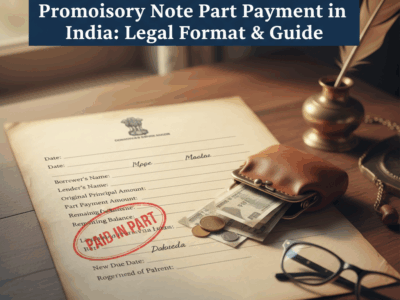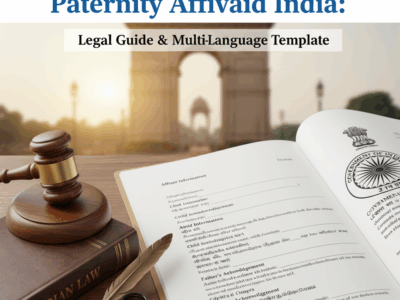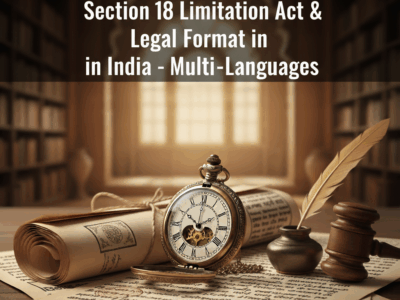For landlords and licensors in India, the three-year limitation period to recover overdue licence fees can be a critical deadline. Once this period expires, the debt becomes legally unenforceable, leaving you with significant financial loss. However, a powerful legal tool exists to reset this clock: the Acknowledgment of Arrears. This comprehensive guide, updated for 2025, provides a deep dive into the strategic use of this document. We’ll deconstruct its legal basis under Section 18 of the Limitation Act, 1963, explore modern applications like e-signatures and part-payments, and offer expert negotiation tactics. Complete with ready-to-use legal templates in English, Hindi, Bengali, Tamil, Telugu, and Marathi, this article is your definitive resource for securing and recovering what you are rightfully owed.
The Acknowledgment of Arrears: A Licensor's Most Powerful Tool
An expert legal analysis of the Acknowledgment of Arrears of Licence Fees in India, exploring its format, use cases, and strategic implications for licensors.
Last Updated: October 2025
1. Strategic Overview
The document "ACKNOWLEDGMENT OF RIGHT TO ARREARS OF LICENCE FEES" is a legal instrument of significant strategic importance in managing licensor-licensee relationships in India. Its primary function is not just to record outstanding dues; its core strategic purpose is to invoke Section 18 of the Indian Limitation Act, 1963, statutorily resetting the time period for initiating legal recovery proceedings. In essence, it breathes new life into a claim that may be approaching the end of its legal enforceability.
By securing a properly executed acknowledgment, a licensor transforms a potentially time-barred claim into a live, actionable one. This act fundamentally alters the legal landscape, providing the licensor with renewed leverage in negotiations and a fortified position should litigation become necessary.
2. Deconstructing the Document
A meticulous clause-by-clause analysis of the Acknowledgment template reveals a structure designed for legal precision. Each component is deliberately included to satisfy the stringent requirements of Indian law.
Anatomy of the Acknowledgment
Title: Clearly defines the instrument's legal character and scope, distinguishing it from a lease.
Debtor Identification: Establishes the identity of the licensee making the admission of liability, preventing ambiguity.
Creditor Identification: Precisely identifies the licensor(s), establishing the "jural relationship" of debtor and creditor.
Debt Specification: Links the acknowledged debt to a specific period, strengthening evidentiary value.
Legal Anchor: The lynchpin, anchoring the debt to a specific Licence Agreement and property.
Execution Block: Contains the critical date and signature, mandated by Section 18 of the Limitation Act.
3. The Legal Engine: Section 18 of the Limitation Act, 1963
The true power of the Acknowledgment document is derived from its interaction with the Indian Limitation Act, 1963. This statute is founded on principles of public policy and prescribes a three-year period for recovering dues like licence fees. Once this period expires, the legal remedy is barred. Section 18 provides a statutory mechanism to "reset the clock."
Visualizing The Limitation "Reset"
This chart illustrates how an acknowledgment extends the period to recover a debt.
The Four Pillars of a Valid Acknowledgment
For an instrument to successfully invoke Section 18, it must satisfy four fundamental conditions. The absence of any one pillar renders it ineffective.
1. In Writing
Oral acknowledgments are insufficient. It must be in a written form, which can include letters or emails.
2. Signed
Must be signed by the debtor or their duly authorized agent. An unsigned note has no legal effect.
3. Acknowledges Liability
Must contain a clear admission of a present and subsisting liability.
4. Before Limitation Expires
The most critical rule: must be signed before the original 3-year limitation period ends.
4. The Foundational Relationship: Licence vs. Lease in Indian Law
The enforceability of the acknowledgment depends on the underlying agreement being a "licence," not a "lease." The primary test is whether the agreement grants the right of **exclusive possession**. If so, it's likely a lease, regardless of its title.
| Feature | Lease (Transfer of Property Act, 1882) | Licence (Indian Easements Act, 1882) |
|---|---|---|
| Nature of Right | Transfer of an interest in property. | Personal, permissive right. No interest transferred. |
| Possession | Grants exclusive possession to the lessee. | Legal possession remains with the licensor. |
| Transferability | Heritable and transferable. | Generally non-transferable and non-heritable. |
| Revocability | Revocable only as per the lease terms. | Generally revocable at the will of the licensor. |
5. Execution and Formalities: Ensuring Legal Enforceability
A legally sound acknowledgment can be rendered worthless if it fails to comply with mandatory formalities, particularly concerning signature and stamp duty.
The Stamp Duty Trap: A "Chameleon Document"
A simple acknowledgment requires only a nominal, fixed stamp duty (e.g., ten rupees in Uttar Pradesh for debts over Rs. 1,000). However, if the document contains any promise to pay, stipulation for interest, or to deliver goods, its legal character transforms. It becomes an "Agreement" or "Bond," attracting a much higher, value-based stamp duty. Failure to pay the correct duty makes the document inadmissible in court.
The Stamp Duty Transformation
Simple Acknowledgment
"I acknowledge I owe Rs. 50,000."
(Nominal Stamp Duty)
Acknowledgment + Promise
"I acknowledge I owe Rs. 50,000 and promise to pay it by next month."
(Ad Valorem Stamp Duty)
Adding a promise to pay fundamentally changes the document's legal nature and its stamp duty requirements, creating a critical legal trap.
6. Strategic Use Cases
The Acknowledgment is an active strategic tool. Its utility extends beyond resetting limitation and plays a crucial role in negotiation, insolvency, and litigation.
1. Averting the Limitation Bar
The primary function: obtain a signature before the 3-year deadline to get a fresh 3-year period to sue for recovery.
2. A Lever for Negotiation
Secure the acknowledgment first, then negotiate payment terms from a position of legal strength, knowing your right to sue is protected.
3. Strengthening Insolvency Proceedings
Under the IBC, this serves as powerful evidence of an undisputed, time-valid operational debt against a corporate licensee.
4. Simplifying Civil Recovery Suits
Acts as a clear admission of liability, significantly simplifying the licensor's burden of proof in court and expediting proceedings.
7. Comparative Instruments
In commercial dealings, the terms "acknowledgment," "receipt," and "settlement agreement" are often confused. They are distinct instruments with different functions.
| Feature | Acknowledgment of Debt | Receipt | Settlement Agreement |
|---|---|---|---|
| Primary Function | Reset the limitation period. | Provide proof of payment received. | Formally resolve a dispute with new terms. |
| Legal Effect | Extends time to sue for the original debt. | Extinguishes debt to the extent of payment. | Supersedes the original claim with a new contract. |
8. Conclusion and Key Recommendations for Licensors
The Acknowledgment is a legal instrument of deceptive simplicity and profound strategic value. Its effectiveness is contingent upon a licensor's diligence, correct timing, and meticulous adherence to legal formalities. To maximize its utility, licensors are advised to adhere to the following key recommendations.
Consult a legal expert when in doubt, especially if the licensee proposes amendments or the case is complex.







